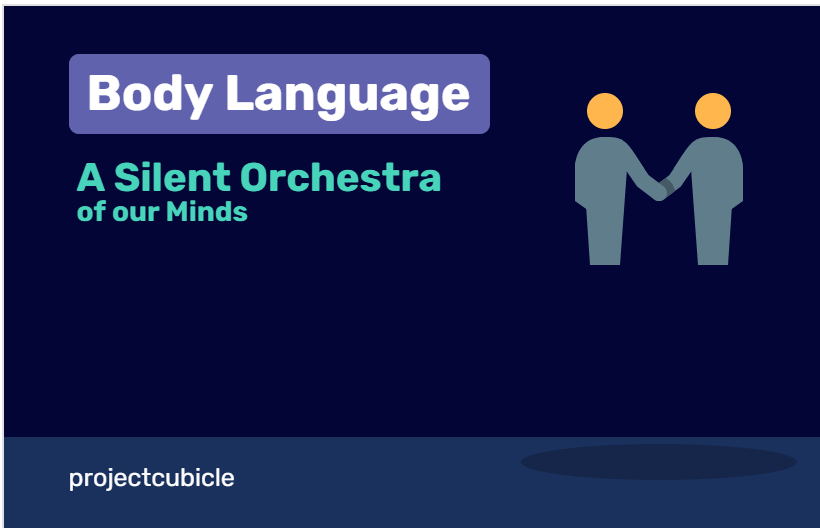A Silent Orchestra of our Minds: Body Language
What is Body Language Definition? What are the Body Language Examples? What is Body Language Definition? How to Read Body Language? What are the most efficient ways of showing that you understand and emphatise with a person?
Table of Contents
Today we are going to share highly classified and E.I.C. (Exclusive Information for Cubiclers) for you to decrypt a person and communicate more actively, meanwhile discussing the most efficient ways of understanding and showing that you understand a person. Personally, as I am a Psychology major, it is certainly one of my favourite topics and it’s an utmost pleasure to write about it here, at Project Cubicle!
Before we begin, I’d like to kindly mention that we will not be able to cover everything about Body Language in one article and it is a massive subject of our psychology. However, I’ll be adding some portals (links to great articles) to help you gain a deeper understanding of How to Read Body Language. You can think about these maps like lightbulbs, and when you light all of them, you have yourself a map! As Project Cubicle, we encourage you to widen your research about the subjects we discuss and have a greater understanding of your environment and empathy about the circumstances you are surrounded with.
And with that.. Let’s begin!
Body Language is not only important in the area of business, but on each and every part of our daily lives. It is a language, however silent it may seem, as intelligent beings, we reserve the power to say quite much, simply using expressions we make with our bodies. It is a massive topic and it’s also how government organizations like FBI spot the real criminals.
But.. What actually is Body Language? Before to take a look at the examples, let’s discuss the definition of body language.
Body Language Definition
Remember Painter Bob? When it comes to Body Language, we all are painters; we paint the current status of ourselves on ourselves. (i.e., we colour ourselves excited, confident, open or close – and so much more!) — Our bodies are our canvas!
Since when? Since our birth! Body Language begins with Perception, our ability to perceive the world, then we look for effective ways to express our interpretations and place in it!
In sum, body language is our means to communicate our physiological, emotional or thought-related responses.
But.. what is considered “Body Language”?
Let’s take a look at body language examples after discussing the definition.
Body Language Examples
This non-verbal language consists of movements of our bodies, facial expressions, tone and volume of our voice and other signals.
Such as..?
A) HEAD
Tilting the Head. Since it exposes the neck, it shows vulnerability. Tilted head is perceived as more attentive, caring, and genuine.
B) NECK
Neck is like our “calming button”. When we are anxious, or stressed out from our daily agendas we touch or stroke our necks as a “pacifying behaviour”. Different parts of neck have different meanings. We all rub the backs, sides and under the chin of our neck. And “The fleshy area under the chin has nerve endings and stroking it lowers heart rate and calms us.” Says Psychology Today.
C) FACE
Face is a whole another story. Above is another great article that covers face more in depth. However, the face is all about Microexpressions.
Microexpressions?
MICROEXPRESSIONS
Microexpressions are hard to catch, but once caught there is no going back!
What is the definition of microexpressions? They are the brief displays of emotions on our faces – gestures of hand and posture.
Why are they called “Micro”?
The psychology of this story is associated with Low-Arousal and High-Arousal. To just make use of it in the boundaries of this content, know that low aroused kids are taught to grow silently and keep their visible expressions in the minimum. In the exact opposite, high aroused children are taught to live and express their emotions freely, using their gestures, laughing instead of smiling with lips pressed into each other.
Don’t the low aroused children use Microexpressions? Yes, they do. We all do. However, you can think of Microexpressions as the large gestures of low aroused kids and therefore adults that are more cautious in expressing themselves with their faces and gesture. And these notions, “Low-arousal” and “High-arousal” may be generalised to talk about a specific region’s characteristics.
a. Eyes
Foolproof fact: Eye Contact is the initiator of a connection. And not only eyes, but also Eyebrows! That is right. Arching Eyebrows generally are indicators of an invitation to connect!
a.1.Eye Blocking
How about Eye Blocking (Covering your Eyes?) It usually expresses frustration or anxiety. And moreover, “the eyelids shut to show determination, while sometimes the eyelids flutter to show that you have screwed up and feel embarrassed.” adds Psychology Today.
a.2. Pupils
This one is quite hard to realise, however once you do, be content because we can say that you now gained the gaze to the “window of the soul” and clearly, the mind.
b. Lips
b.1. Smile
Meet the “Welcome” sign: A Genuine Smile! A smile might be a perfect way to create the best first impression on someone you meet! Once again, the article above emphasises the influence of smiling on our happiness!
D) SHOULDERS & CHEST
Shoulders and Chest are usually perceived as symbols of masculinity. Wide shoulders and narrow hips are related to strength and vitality. The hold of shoulders also conveys status in a hierarchy.
E) ARMS
Did you see Open Arms? Time to make the move!
F) HANDS
Hands, similar to face, convey another story. Confidence lets your fingers flow more freely, leaving more space between them. However insecurity does the exact opposite. Rubbing the hands might be an indicator of stress and steepling the fingers might be the sign of confidence.
F.1) Touch
Psychology Today indicates that a light touch might display harmony and trust.
“In one study, people in the UK, the US, France, and Puerto Rico were observed while sitting at a coffee shop. The British and the Americans hardly touched, and the French and the Puerto Ricans freely touched in togetherness.”
This example also emphasises the importance of culture in Body Language which we are going to discuss further in a moment.
G) LEGS
Think about the tradition where our parents used to say “Don’t cross your legs before your grandmother”, the reason for that saying is that it indicates comfort. And sometimes too much comfort is perceived disrespectful by our elders. Not only that but it also shows the person that you feel comfortable around that person and that they can take their time to get their thoughts in order and converse with you at ease.
H) FEET
In or out? That is the question the body asks during perception, to our mind. And our mind either says, “Yes, I am pleased to be here.” or “No, I would not like to be here.”
How to Read Body Language?
MIRROR (NEURONS)
Mirroring as explained in Psychology Today, is “A common form of body language is mirroring another person’s gestures and mannerisms; mirroring also includes mimicking another person’s speech patterns and even attitudes.”
MIRRORING & PERSUASION
Mirroring is used commonly in persuasion. For example, in areas like Marketing, this technique is used to build a genuine connection to make the client have a positive impression. Studies show that the customers are more inclined to buy from a salesperson who they believe in their motives and sincerity.
Conclusion? Mirroring is capable of directing and even ALTERING our perception!
Are We Conscious Of Our Body Language?
At most times, we are not. Since these processes unfold in the flow of our lives, we also are not programmed to monitor and keep track of our every reaction. Therefore, we are not conscious of our reactions at most times and that is because we are unaware of our perceptions.
Can We Be Conscious Of Our Body Language?
For sure. – With practice. Let’s see what we can do to create a more open atmosphere to communicate in!
The best way to do that is to use empathy at all times. Would you like that behaviour to be done on you? Would you be disturbed or pleased? For an instance:
- Too much eye contact makes a person feel uncomfortable.
- Speaking faster or too fast in the room might make people around you feel pressured.
- Nodding periodically shows a person that you are listening, paying attention, and genuinely caring what they have to say.
- And if you are talking too slow or slower they might feel that they have a lower status.
- Crossing your arms might display you as aggressive or unopen to communication.
- Keeping hands visible can help show you as cool and at ease.
- Mirroring the handshake of a person might make them feel understood. Too much pressure might be understood as the means of dominance, and little pressure might make them think that you are a person with low self-confidence.
- Standing up straight, with your shoulders held back and relaxed, meanwhile leaning forward might also indicate confidence.
Yes…
BODY LANGUAGE IS UNIVERSAL.
However…
UNIVERSAL AS IT IS, IT DIFFERS FROM CULTURE TO CULTURE.
Before we begin, it is vital to emphasise that this does not indicate any sorts of discrimination or racism. It simply means that the cultures have developed differently, using unique forms of their own expression, and now it has become a part of their daily lives as it has become ours.
Below, we made a list for you of common gestures and their meanings used around in different regions of the world.
However, keep in mind that non-verbal language may be culturally, or even situationally defined.
Now, this part below is important and requires serious attention. You might seen infographics about Body Language, unfortunately, it does not always work as it is told.
| 1) SMILING | In Western Cultures:
– Indication of pleasure and happiness |
In Asian Cultures:
– Indication of being embarassed |
| 2) EYE CONTACT | In Western Cultures:
– Important to maintain while having a conversation
|
In Asian & African Cultures:
– Considered rude to maintain, especially when speaking to a person with senior status |
| 3) CLOSING EYES | In Japan:
– A sign of listening and attending |
In Other Countries:
– A sign of boredom or worse, sleepiness |
| 4) GIVING SOMETHING WITH YOUR LEFT/RIGHT HAND | In Many Countries:
– Does not matter which hand you use for giving something |
In Middle East & Asian Countries:
– Left hand is not acceptable, right hand must be used |
| 5) ARM GESTURES | In Italy:
– Expressive arm gestures |
In Germany & England:
– Stable arms |
| 6) FINGER GESTURES | · Critical across cultures
|
In Arabic Countries:
– “Thumbs Up” considered an insult |
| 7) TOUCHING HEAD | In Western Countries:
– A friendly gesture |
In Buddhist Countries:
– Head as the “home” of soul, should not be touched |
| 8) CHECKING THE CLOCK | In Most Cultures:
– Concern of punctuality |
In Middle East:
– An insult, indication of you not perceiving your current occupation as the best way to use your time |
Do All Non-Verbal Behaviours Have a Reason?
Non-verbal behaviours have generally developed on one vital instinct. Fight, or Flight? To survive. According to Evolutionary Scientists, all primates demonstrate these responses and similar self-relaxing gestures. These behaviours are innate.
Yet, some of our behaviours still happen to be a mystery for us to decrypt.
Importance of Right Interpretation of Body Language
As we highlighted by mentioning the differences between cultures, we would be mistaken if we are to think about a gesture with a single meaning. In advance to our cultures, we are individual beings that lead our own lives and make our own decisions. When we cross our arms it might not be a sign of Agression for us and instead may indicate that we are comfortable standing there.
For this reason, while interpreting what people would like to let you know unconsciously with their Body Language, it is important to realise their own behaviour patterns to be able to decrypt what their actual intention.
Is it Possible to Hide our Emotional Status?
Shortly, no.
As social beings, we depend on the display and expression of our emotions, thoughts, and intentions to survive which we discussed once again in the reasons of our non-verbal behaviour.
Our body language, mind-wise, unveils where we actually are and not pretend to be.
To repeat, Our Body is our canvas.
When Travelling or Meeting a Foreigner: Have an Idea About Body Language of Their Culture
When you are travelling across the world, learning the body language of the culture you are going to be surrounded with is highly critical. As we exemplified on the table above, each gesture might not mean the same thing in every part of the world. Therefore, while you are learning the basic phrases to ask for water in their language, we extremely suggest that you also have an idea about their body language. Furthermore, whether that region is considered low or high arousal.
Body Language in Workplace
In the above we disccuss the body language definition and give examples to guide you on how to read body language. But do you think Body Language is important?
Well…
STATISTICALLY SPEAKING:
67% of hiring managers indicate the lack of eye contact as the BIGGEST MISTAKE candidates make!
26% of applicants are rejected because they fidget too much!
21% are rejected due to a weak handshake!
39% put off if a candidate fails to smile!
In conclusion, Your Canvas (What you say with your Body) matters!
And that is the end of another great topic.
For now.
Let’s review what we discussed in this article. We have covered the basics of Body Language definition with examples, discussing what counts and not counts as Body Language, furthermore we have exemplified cultural and individual differences, indicating how important and critical it is in our both work and daily lives.
What more would you like to see here at Project Cubicle? Is there a certain subject you want the team to cover? Let us know!
We are excited! Stay tuned for more great subjects, coming real soon..
It is obviously apparent to cover everything about Body Language in one article.
However…
If you are still hungry for more to understand How to Read Body Language, see this great article from former FBI Agent, Joe Navarro.











